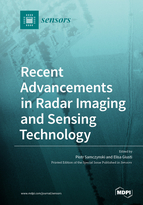Recent Advancements in Radar Imaging and Sensing Technology
A special issue of Sensors (ISSN 1424-8220). This special issue belongs to the section "Remote Sensors".
Deadline for manuscript submissions: closed (31 March 2020) | Viewed by 61911
Special Issue Editors
Interests: SAR/ISAR; passive radars; passive SAR/ISAR; noise radars; radar signal processing
Special Issues, Collections and Topics in MDPI journals
Interests: radar imaging tecniques; Inverse synthetic aperture radar (ISAR); interferometric ISAR (InISAR); radar polarimetry; ATR by using radar images
Special Issues, Collections and Topics in MDPI journals
Special Issue Information
Dear Colleagues,
For the last decades radar imaging and sensing technology has made major scientific and technical progress. The first applications of this technology were devoted mostly to military uses. Nowadays, radar imaging and sensing techniques are widely used in many civilian applications, ranging from medicine, though security, to safety assistance sensors widely used in transportation, including cars, trains, and airplanes, among others. These technologies are beginning to be present all around us.
With the fast development of new hardware platforms with advanced computational resources that are widely available on the market, novel signal processing techniques—enabling enhanced functionalities of radar systems—have been implemented. This, in turn, makes it possible to apply new technology in radar imaging such as, for example, passive radar sensing. Just a few years ago this type of sensing was at a very low technical readiness level, and today it has become a mature technology that will be probably offered on the market within the next few years. Moreover, the ever wider bandwidth of the currently available receivers allow the creation of very high resolution radar images utilizing both active and passive radar technology.
The aim of this Special Issue is to gather the latest research results in the area of modern radar technology using active and/or radar imaging sensing techniques in different applications, including both military use and a broad spectrum of civilian applications. Contributions from leading experts in this field of research will be collected and presented in this special journal issue.
This Special Issue aims to highlight the advances in the radar imaging and sensing technology. Topics include, but are not limited to:
- High Resolution Radar Imaging
- Novel SAR and ISAR Imaging Techniques
- Passive Radar Imaging Technology
- Modern Civilian Applications of Using Radar Technology for Sensing
- Multiband and/or Multistatic Radar Imaging
- Novel Fusion Techniques in Radar Technology
- Multiband and/or Multistatic Radar Sensing
- Multifunction Radar Sensing
Dr. Piotr Samczynski
Dr. Elisa Giusti
Guest Editors
Manuscript Submission Information
Manuscripts should be submitted online at www.mdpi.com by registering and logging in to this website. Once you are registered, click here to go to the submission form. Manuscripts can be submitted until the deadline. All submissions that pass pre-check are peer-reviewed. Accepted papers will be published continuously in the journal (as soon as accepted) and will be listed together on the special issue website. Research articles, review articles as well as short communications are invited. For planned papers, a title and short abstract (about 100 words) can be sent to the Editorial Office for announcement on this website.
Submitted manuscripts should not have been published previously, nor be under consideration for publication elsewhere (except conference proceedings papers). All manuscripts are thoroughly refereed through a single-blind peer-review process. A guide for authors and other relevant information for submission of manuscripts is available on the Instructions for Authors page. Sensors is an international peer-reviewed open access semimonthly journal published by MDPI.
Please visit the Instructions for Authors page before submitting a manuscript. The Article Processing Charge (APC) for publication in this open access journal is 2600 CHF (Swiss Francs). Submitted papers should be well formatted and use good English. Authors may use MDPI's English editing service prior to publication or during author revisions.
Keywords
- Radar Signal Processing Techniques
- Radar Imaging
- SAR
- ISAR
- PCL
- PBR
- Multiband Processing
- Multistatic Processing
- Multistatic Radar Imaging
- Multifunction Radar
- Modern Radar Applications








